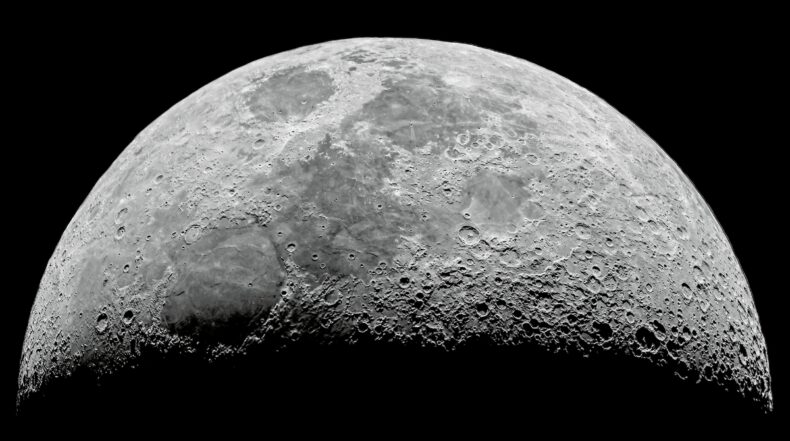India’s Chandrayaan-1 mission came with significant findings after detecting presence of water on the lunar surface.
According to ISRO scientists, a probe onboard the Chandrayaan-2 orbiter mission has successfully validated its predecessor’s discovery of hydroxyl and water molecules on the lunar surface, opening doors for future missions on lunar exploration.
The research findings are published in the Journal Current Science, stating how researchers used the data from the imaging infrared spectrometer (IIRS) present on the Chandrayaan-2 orbiter; it is an instrument that helps in understanding the mineral composition of the lunar surface
. Data from three strips on the Chandrayaan-2 IIRS sensor for hydration reported in the publication on August 10 research article that, “The initial data analysis from IIRS demonstrates the presence of widespread lunar hydration and unambiguous detection of OH and H2O signatures between 29 degrees north and 62 degrees north latitude,”.
The first lunar mission brought the initial evidence for water molecules on the surface of our natural satellite, Chandrayaan-1 was supplemented with the NASA-provided Moon Mineralogy Mapper (M3) experiment carried on Chandrayaan-1 spacecraft.
Dr Mylswamy Annadurai, Former Director of ISRO’s UR Rao Satellite Center, said that with the M3 experiment, we had reached the tip of the iceberg. Still, we will need “double and triple confirmation” before pursuing more elaboration exploration missions on the moon.
He added, “In a breakthrough for us, the data from the old M3 sensor and the new Chandrayaan 2 sensor have matched. The orbiter of Chandrayaan 2 has a 5 micron (wider spectrometer); hence it unambiguously confirms the findings of Chandrayaan-1”.
The scientists are looking forward to the complete picture with the data provided by the Chandrayaan missions, which will be made available in the future.

IITH successfully establishes an astronomical observatory
Indian Institute of Technology, Hyderabad (IITH) campus establishes a telescope with the Crayford focuser and 1650 mm focal length, also boasts of a 355 mm optical diameter mirror, the second largest among the IITs, after IIT Kanpur.
B S Murty, the Director of IIT, while explaining to the students the use of the reflector telescope established at IITH in Sangareddy district on Sunday, said that it is the first step towards creating awareness among students.
The main aim of the IITH telescope is to facilitate astronomical outreach activities and a student’s training program.
The project is being headed by Mayukh Pahari, Assistant Professor in the Department of Physics. On its inauguration day, Mr Mayukh said that the telescope here is unlike other observatories designed for the outreach programme.
The IITH facility will provide a chance for candidates to work with high-quality astronomical images from deep-sky objects. Additionally, it will enable witnessing “transient events so that school/ college students may have opportunities to contribute to astronomical research.”
The telescope facility at IITH can extravagantly utilise such a large mirror and a Crayford focuser with the truss tube design, which will ease the observation of the deep sky and faint objects that cannot be detected with a small telescope.
Even small craters on the lunar surface and Saturn rings are tiny features that the telescope can resolve. Another significant feature is its advanced digital camera capable of recording meteor showers.

Voice and Video Calls Can Now Be End-to-End Encrypted on Facebook Messenger
Facebook has come up with a new end-to-end encryption option in its Messenger app, considering increasing audio and video calls in the past year.
Most of the products by Facebook, like Whatsapp, already come with end-to-end encryption where no one, including Facebook, can read your messages or listen to your calls.
End-to-end encryption hasn’t yet reached neither group chats nor group voice and video calls. Facebook indicated testing these features with some of its users in the forthcoming weeks.
A somewhat quirky feature on Messenger this time in which you can control its disappearing message feature. It will allow users to control the duration when someone can see their messages in a chat before they disappear.
With this update, users have more privacy options to choose from and specify how soon they
want their messages to disappear from five seconds to 24 hours.
Previously Facebook had rolled out its end-to-end encryption in its Messenger app in 2016. In a blog post, Facebook stated that there are over 150 million video calls per day which makes sense when they have decided to launch these features.
Additionally, the company remarked that conversations would be encrypted by default from 2022 at its earliest.













